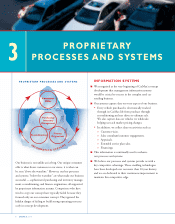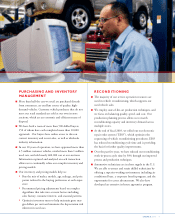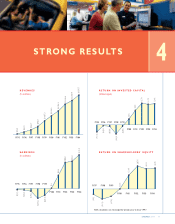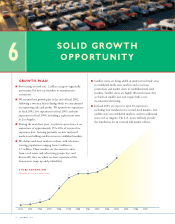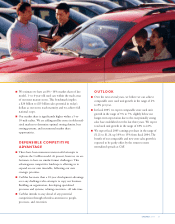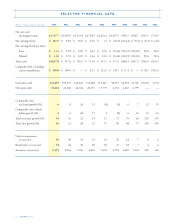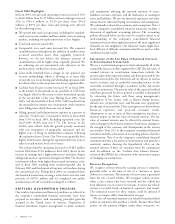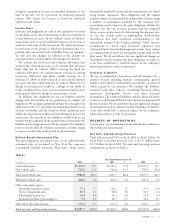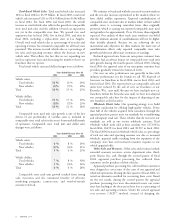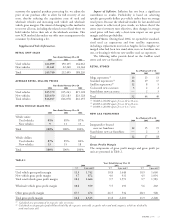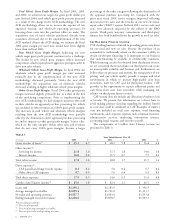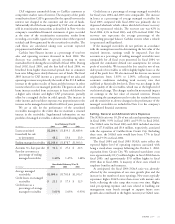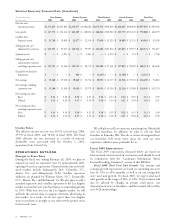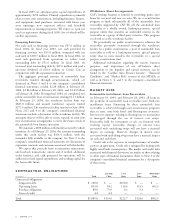CarMax 2004 Annual Report Download - page 20
Download and view the complete annual report
Please find page 20 of the 2004 CarMax annual report below. You can navigate through the pages in the report by either clicking on the pages listed below, or by using the keyword search tool below to find specific information within the annual report.18
CARMAX
2004
Fiscal 2004 Highlights
In fiscal 2004, net sales and operating revenues increased 16%
to $4.60 billion from $3.97 billion and net earnings increased
23% to $116.5 million, or $1.10 per share, from $94.8
million, or $0.91 per share. Sales and earnings were affected
by the following items:
■We opened nine used car superstores, including five standard-
sized stores in new markets and four satellite stores in existing
markets, including one replacement store in Los Angeles.
■Total used units increased 18%.
■Comparable store used units increased 6%. The expected
cannibalization resulting from the addition of satellite stores
occurred somewhat faster than originally projected;
however, we do not believe the ultimate amount of
cannibalization will be higher than originally planned. We
are achieving our net incremental sales objectives in the
markets where satellites have been added.
■Gross profit benefited from a change in our appraisal cost
recovery methodology, which is allowing us to more fully
recover the cost of our buying and wholesaling operations with
no adverse effect on the acceptance rate for our appraisal offers.
■CarMax Auto Finance income increased 3% in fiscal 2004,
as the benefit of the growth in our portfolio of CAF loans
was largely offset by the return to more normalized spreads
in the second half of the year. During fiscal 2002, fiscal
2003, and the first half of fiscal 2004, CAF benefited from
the unusually low interest rate environment, with consumer
rates falling more slowly than our cost of funds.
■Selling, general, and administrative expenses as a percent of
sales (the “SG&A ratio”) increased to 10.2% in fiscal 2004
from 9.9% in fiscal 2003. Excluding separation costs, the
fiscal 2003 SG&A ratio was 9.7%. The increase in the
SG&A ratio reflects both the growth penalty associated
with our resumption of geographic expansion and the
higher costs of being an independent company following
the separation from Circuit City. New stores generally have
higher SG&A ratios during the approximately four years it
takes to reach mature levels of revenues.
Net cash provided by operations increased to $148.5 million
in fiscal 2004 from $72.0 million in fiscal 2003, driven by the
increase in earnings and a slight reduction in inventory, despite
adding nine used car superstores during fiscal 2004. The decrease
in inventory reflects both higher-than-normal inventories at the
end of fiscal 2003 resulting from weather-impeded sales in
February 2003 and the disposal of four new car franchises during
the current fiscal year. During fiscal 2004, we completed three
sale-leaseback transactions covering a total of nine stores for total
proceeds of $107.0 million and we completed two public
securitizations of CAF receivables totaling $1.11 billion.
CRITICAL ACCOUNTING POLICIES
Our results of operations and financial condition, as reflected in
the company’s consolidated financial statements, have been
prepared in accordance with accounting principles generally
accepted in the United States of America. Preparation of
financial statements requires management to make estimates
and assumptions affecting the reported amounts of assets,
liabilities, revenues, expenses, and the disclosures of contingent
assets and liabilities. We use our historical experience and other
relevant factors when developing our estimates and assumptions.
We continually evaluate these estimates and assumptions. Note 2
to the company’s consolidated financial statements includes a
discussion of significant accounting policies. The accounting
policies discussed below are the ones we consider critical to an
understanding of the company’s consolidated financial
statements because their application places the most significant
demands on our judgment. Our financial results might have
been different if different assumptions had been used or other
conditions had prevailed.
Calculation of the Fair Value of Retained Interests
in Securitization Transactions
We use a securitization program to fund substantially all of the
automobile loan receivables originated by CAF. The fair value of
retained interests in securitization transactions includes the
present value of the expected residual cash flows generated by the
securitized receivables, the restricted cash on deposit in various
reserve accounts, and an undivided ownership interest in the
receivables securitized through a warehouse facility and certain
public securitizations. The present value of the expected residual
cash flows generated by the securitized receivables is determined
by estimating the future cash flows using management’s
assumptions of key factors, such as finance charge income,
default rates, prepayment rates, and discount rates appropriate
for the type of asset and risk. These assumptions are derived from
historical experience and projected economic trends.
Adjustments to one or more of these assumptions may have a
material impact on the fair value of retained interests. The fair
value of retained interests may be affected by external factors,
such as changes in the behavior patterns of customers, changes in
the strength of the economy, and developments in the interest
rate markets. Note 2(C) to the company’s consolidated financial
statements includes a discussion of accounting policies related to
securitizations. Note 4 to the company’s consolidated financial
statements includes a discussion of securitizations and provides a
sensitivity analysis showing the hypothetical effect on the
retained interests if there are variations from the assumptions
used. In addition, see the “CarMax Auto Finance Income”
section of this MD&A for a discussion of the current year impact
of changing our assumptions.
Revenue Recognition
We recognize revenue when the earnings process is complete,
generally either at the time of sale to a customer or upon
delivery to a customer. The majority of our revenue is generated
from the sale of used vehicles. We recognize vehicle revenue
when a sales contract has been executed and the vehicle has
been delivered, net of a reserve for returns. A reserve for vehicle
returns is recorded based on historical experience and trends.
The estimated reserve for these returns could be affected if
future occurrences differ from historical averages.
We also sell extended warranties on behalf of unrelated third
parties to customers who purchase a vehicle. Because these third
parties are the primary obligors under these warranties, we


